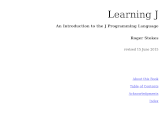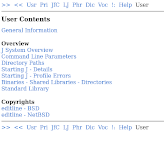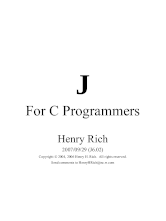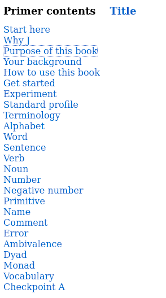Last Updated on May 5, 2023
The J programming language, developed in the early 1990s by Kenneth E. Iverson and Roger Hui, is an array programming language based primarily on APL (also by Iverson). It’s available on a wide variety of computers and operating systems. J is distinguished by its simple and consistent rules, a large set of built-in capabilities, powerful facilities for defining new operations, and a general and systematic treatment of arrays.
The J system provides: an engine for executing J; various front ends that provide user interfaces to the J engine; a library, written in J, that provides an IDE (interactive development environment), numerous tools, utilities, demos, tutorials; and online documentation.
J is a very terse array programming language, and is most suited to mathematical and statistical programming, especially when performing operations on matrices. It has also been used in extreme programming and network performance analysis.
J supports function-level programming via its tacit programming features.
J is free and open-source software published under the GNU General Public License version 3.
1. Learning J by Roger Stokes

This book is meant to help the reader to learn the computer-programming language J.
The book is organized as follows. Part 1 is a basic introduction which touches on a variety of themes. The aim is to provide the reader, by the end of Part 1, with an overview and a general appreciation of the J language. The themes introduced in Part 1 are then developed in more depth and detail in the remainder of the book.
2. User Manual
 The User Manual documents the J programming environment, standard library and various other topics such as DLL calls and ODBC.
The User Manual documents the J programming environment, standard library and various other topics such as DLL calls and ODBC.
The manual has sections on:
- J System Overview
- Command Line Parameters
- Directory Paths
- Starting J – Details
- Starting J – Profile Errors
- Binaries – Shared Libraries – Directories
- Standard Library
3. J for C Programmers by Henry Rich
 The purpose of this book is to help experienced C programmers see what J is all about.
The purpose of this book is to help experienced C programmers see what J is all about.
This book will tell you enough about J for you to use it as a language for developing serious applications, but it’s about more than learning the J language: it’s also about ‘thinking big’ in programming, and how programming in J is fundamentally different from programming in C.
C programs deal intimately with scalars (single numbers and characters), and even when they combine those scalars into arrays and structures, the operations on the arrays and structures are defined by operations on the scalars. To ensure that each item of an array is operated on, loops are created that visit each element of the array and perform a scalar operation on the element.
4. Primer & The J Dictionary
 The J Dictionary is the authoritative and definitive specification of the J language. It can be used to learn J, but the fact that it covers all of the language concisely, yet completely and rigorously, with more emphasis on the complex than the mundane, does scare some of us away.
The J Dictionary is the authoritative and definitive specification of the J language. It can be used to learn J, but the fact that it covers all of the language concisely, yet completely and rigorously, with more emphasis on the complex than the mundane, does scare some of us away.
This online book provides a kinder, gentler start for beginners. This book takes you along a path in easy steps to the point where you can write an application in J. Along the way you will be introduced to all the key ideas in J by seeing them in simplified and specific contexts. At the end, you will be able to write real programs in J, and you will also be comfortable in using the J Dictionary as a reference for your work as a J programmer.
The purpose of this online book is to get you up to speed where you can use the J Dictionary in a manner that makes you wonder why you ever bothered with this simple stuff.
All books in this series:
| Free Programming Books | |
|---|---|
| Ada | ALGOL-like programming language, extended from Pascal and other languages |
| Agda | Dependently typed functional language based on intuitionistic Type Theory |
| Arduino | Inexpensive, flexible, open source microcontroller platform |
| Assembly | As close to writing machine code without writing in pure hexadecimal |
| Awk | Versatile language designed for pattern scanning and processing language |
| Bash | Shell and command language; popular both as a shell and a scripting language |
| BASIC | Beginner’s All-purpose Symbolic Instruction Code |
| C | General-purpose, procedural, portable, high-level language |
| C++ | General-purpose, portable, free-form, multi-paradigm language |
| C# | Combines the power and flexibility of C++ with the simplicity of Visual Basic |
| Clojure | Dialect of the Lisp programming language |
| ClojureScript | Compiler for Clojure that targets JavaScript |
| COBOL | Common Business-Oriented Language |
| CoffeeScript | Transcompiles into JavaScript inspired by Ruby, Python and Haskell |
| Coq | Dependently typed language similar to Agda, Idris, F* and others |
| Crystal | General-purpose, concurrent, multi-paradigm, object-oriented language |
| CSS | CSS (Cascading Style Sheets) specifies a web page’s appearance |
| D | General-purpose systems programming language with a C-like syntax |
| Dart | Client-optimized language for fast apps on multiple platforms |
| Dylan | Multi-paradigm language supporting functional and object-oriented coding |
| ECMAScript | Best known as the language embedded in web browsers |
| Eiffel | Object-oriented language designed by Bertrand Meyer |
| Elixir | Relatively new functional language running on the Erlang virtual machine |
| Erlang | General-purpose, concurrent, declarative, functional language |
| F# | Uses functional, imperative, and object-oriented programming methods |
| Factor | Dynamic stack-based programming language |
| Forth | Imperative stack-based programming language |
| Fortran | The first high-level language, using the first compiler |
| Go | Compiled, statically typed programming language |
| Groovy | Powerful, optionally typed and dynamic language |
| Haskell | Standardized, general-purpose, polymorphically, statically typed language |
| HTML | HyperText Markup Language |
| Icon | Wide variety of features for processing and presenting symbolic data |
| J | Array programming language based primarily on APL |
| Java | General-purpose, concurrent, class-based, object-oriented, high-level language |
| JavaScript | Interpreted, prototype-based, scripting language |
| Julia | High-level, high-performance language for technical computing |
| Kotlin | More modern version of Java |
| LabVIEW | Designed to enable domain experts to build power systems quickly |
| LaTeX | Professional document preparation system and document markup language |
| Lisp | Unique features - excellent to study programming constructs |
| Logo | Dialect of Lisp that features interactivity, modularity, extensibility |
| Lua | Designed as an embeddable scripting language |
| Markdown | Plain text formatting syntax designed to be easy-to-read and easy-to-write |
| Objective-C | Object-oriented language that adds Smalltalk-style messaging to C |
| OCaml | The main implementation of the Caml language |
| Pascal | Imperative and procedural language designed in the late 1960s |
| Perl | High-level, general-purpose, interpreted, scripting, dynamic language |
| PHP | PHP has been at the helm of the web for many years |
| PostScript | Interpreted, stack-based and Turing complete language |
| Prolog | A general purpose, declarative, logic programming language |
| PureScript | Small strongly, statically typed language compiling to JavaScript |
| Python | General-purpose, structured, powerful language |
| QML | Hierarchical declarative language for user interface layout - JSON-like syntax |
| R | De facto standard among statisticians and data analysts |
| Racket | General-purpose, object-oriented, multi-paradigm, functional language |
| Raku | Member of the Perl family of programming languages |
| Ruby | General purpose, scripting, structured, flexible, fully object-oriented language |
| Rust | Ideal for systems, embedded, and other performance critical code |
| Scala | Modern, object-functional, multi-paradigm, Java-based language |
| Scheme | A general-purpose, functional language descended from Lisp and Algol |
| Scratch | Visual programming language designed for 8-16 year-old children |
| SQL | Access and manipulate data held in a relational database management system |
| Standard ML | General-purpose functional language characterized as "Lisp with types" |
| Swift | Powerful and intuitive general-purpose programming language |
| Tcl | Dynamic language based on concepts of Lisp, C, and Unix shells |
| TeX | Markup and programming language - create professional quality typeset text |
| TypeScript | Strict syntactical superset of JavaScript adding optional static typing |
| Vala | Object-oriented language, syntactically similar to C# |
| VHDL | Hardware description language used in electronic design automation |
| VimL | Powerful scripting language of the Vim editor |
| XML | Rules for defining semantic tags describing structure ad meaning |
